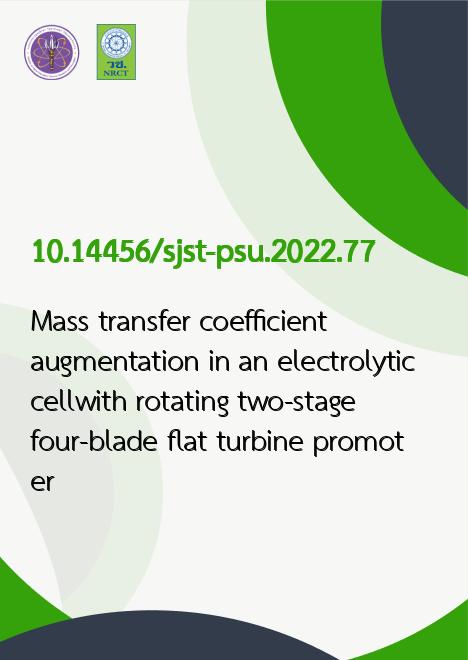
|
Mass transfer coefficient augmentation in an electrolytic cellwith rotating two-stage four-blade flat turbine promoter |
|---|---|
| รหัสดีโอไอ | |
| Creator | 1. K. Ramesh Chandra 2. M. Venkateswara Rao 3. M. Venkata Ratnam 4. D. Subba Rao 5. N. Chitti Babu |
| Title | Mass transfer coefficient augmentation in an electrolytic cellwith rotating two-stage four-blade flat turbine promoter |
| Publisher | Research and Development Office, Prince of Songkla University |
| Publication Year | 2565 |
| Journal Title | Songklanakarin Journal of Science an Technology (SJST) |
| Journal Vol. | 44 |
| Journal No. | 2 |
| Page no. | 556-561 |
| Keyword | electrolytic cell, limiting current, mass transfer coefficient, turbine, electrode support |
| URL Website | https://rdo.psu.ac.th/sjst/index.php |
| ISSN | 0125-3395 |
| Abstract | The current experimental study looks at how the limiting current density is approached on using rotating 2-stage 4-blade flat turbine promoters to improve mass transfer coefficient in an open electrolytic cell. The mass transfer data are obtainedat microelectrodes fixed on the cell wall and electrode support using an electrochemical method. The electrolyte was equimolal inpotassium ferricyanide, potassium ferrocyanide and excess sodium hydroxide. The mass transfer coefficients were calculatedusing limiting current data from a diffusion-mediated electrode reduction reaction at the microelectrodes attached to the electrodesupports. The limiting current technique has been particularly chosen in view of its accuracy, simplicity, negligible chemicalpolarization, and absence of any physical change to the reacting surface even after long exposure. The effects of geometricparameters such as turbine diameter (0.05-0.09 m), blade width (0.005-0.015m), turbine rotational speeds (250-1250 rpm) andelectrolyte velocity (0.567x10-3to 7.93x10-3 m/s) were investigated. The mass transfer coefficients were increased by theturbulence created by rotation of the promoter turbines. The mass transfer correlation was formed in terms of dimensionlessnumbers: Schmidt number (Sc), Sherwood number (She), rotational Reynolds number (Rer), and flow Reynolds number (Ref). |
